Azure Interview Questions and Answers: An Overview
Azure is a cloud computing platform that offers various cloud services to help businesses build, deploy, and manage applications on the global network. In today's digital world, cloud computing plays a crucial role in modern businesses, and Microsoft's Azure Cloud is the leading cloud platform. Whether you are an Azure professional or an aspiring individual to enter this field, you will need some insightful questions and answers to excel in your next Azure interview.
In this Azure Tutorial, we will explore Azure Interview Questions and Answers for Freshers, and Azure Interview Questions and Answers for experienced professionals. Additionally, we'll also delve into Azure Certification Training which will provide a comprehensive guide to help you enhance your Azure skills.
Azure Interview Questions and Answers for Beginners
1. Describe Cloud Computing.
Cloud computing uses internet-based computers to store, manage, and process data. Rather than managing its own servers, third-party companies such as Microsoft and AWS provide and manage infrastructure for a fee based on usage time. It improves speed, flexibility, and scalability while providing high fault tolerance and system availability dependent on application needs.
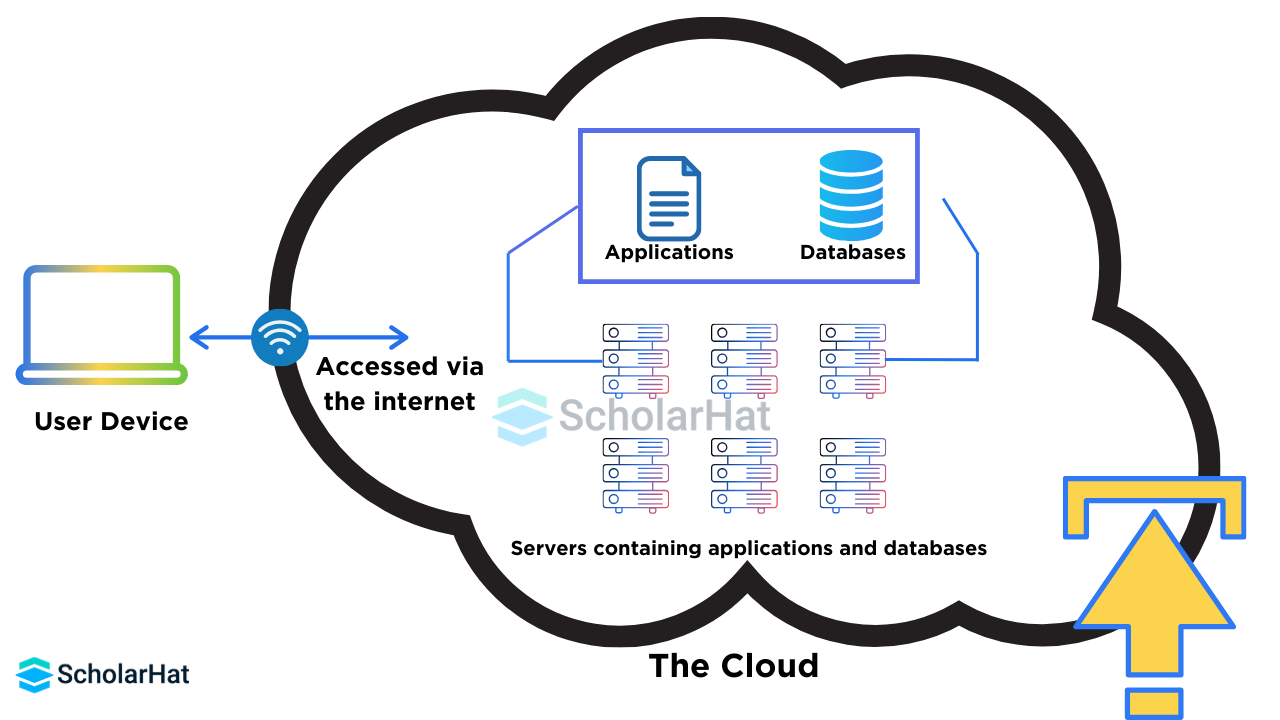
2. Describe the Azure Cloud Service concept.
Microsoft's Azure Cloud Service is a platform as a service (PaaS) offering aimed at highly scalable, dependable, and available applications at a low operational cost. It makes use of virtual VMs, which allow developers to remotely install and control software. This service is perfect for deploying multi-tier web applications, as it allows for the creation of instances and the definition of roles such as web or worker roles for distributed processing. Each role in the cloud service has its own set of configuration and application files, allowing for simple and flexible scalability.
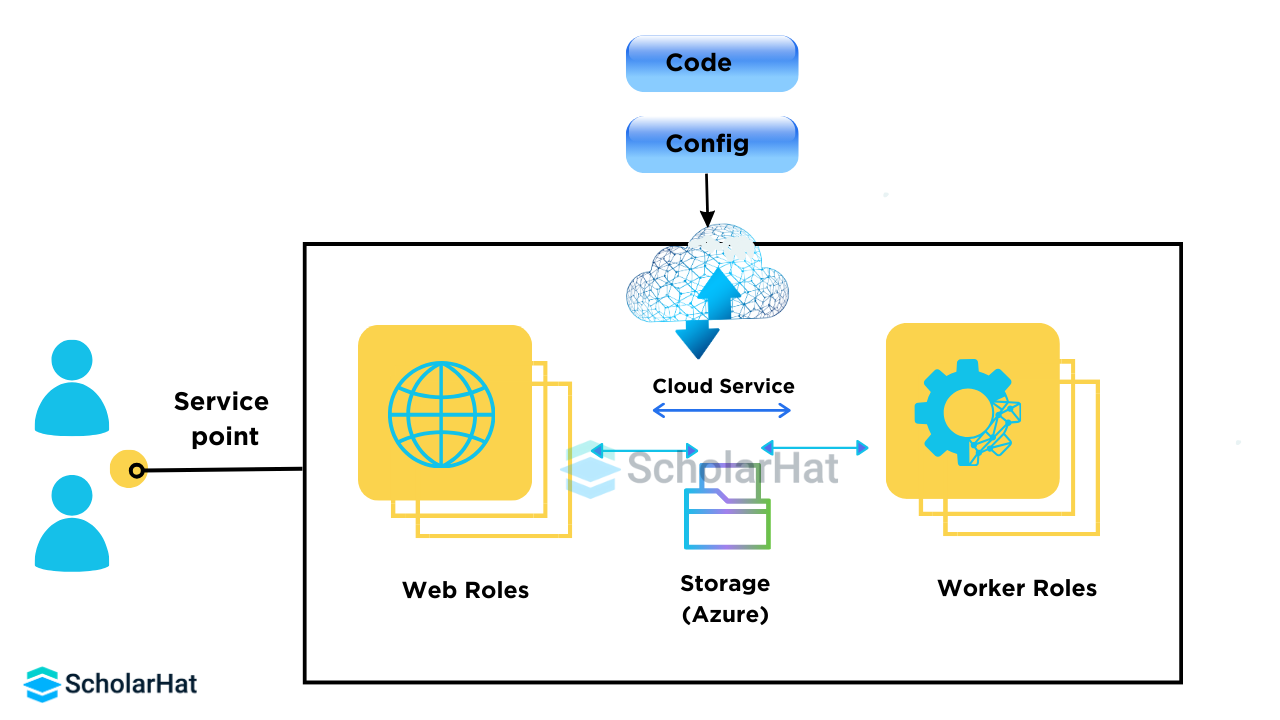
3. What are the various cloud deployment models available?
There are three cloud deployment models available:
- Public Cloud: The cloud provider's public cloud, with shared server resources across several applications.
- Private Cloud: Exclusively owned by us or offered by the cloud provider. Applications can be hosted on-premises or on a dedicated server provided by the cloud provider.
- Hybrid Cloud: A hybrid of both public and private clouds. It could entail deploying on-premise servers for sensitive data processing & leveraging public cloud features for hosting public-facing applications.
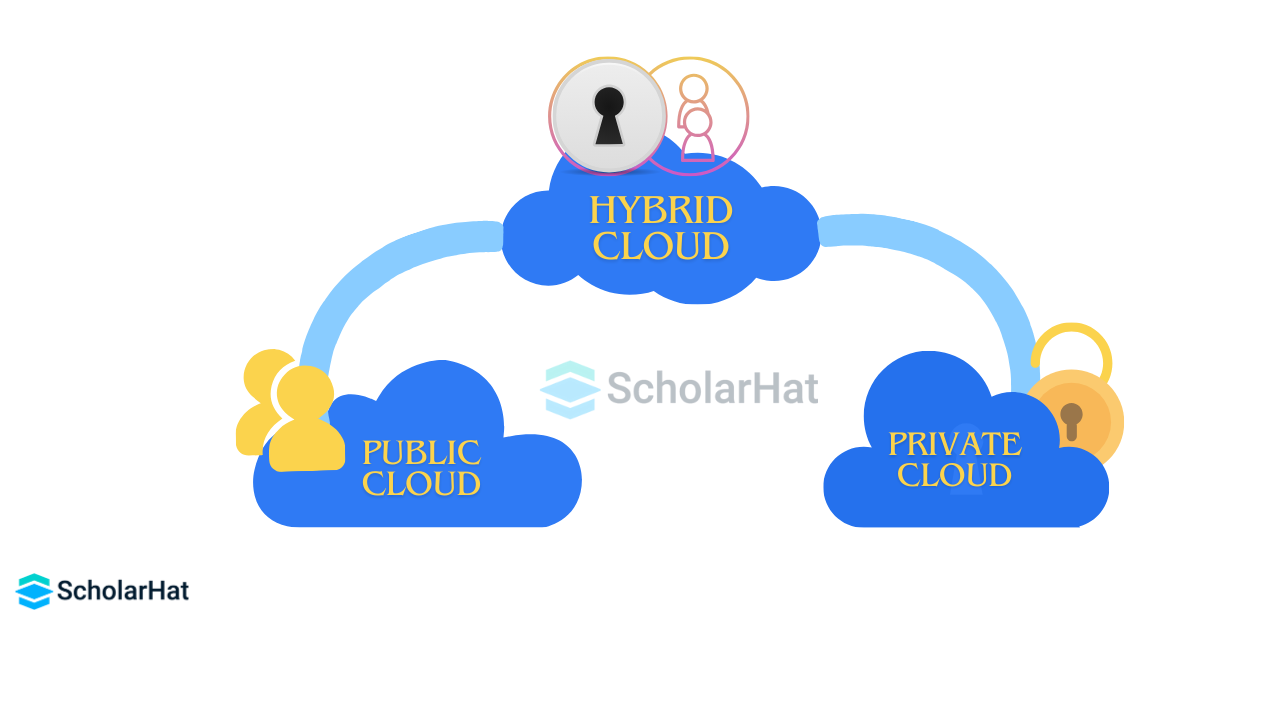
4. Explain an Azure role instance.
A role instance is nothing more than a virtual machine on which application code executes with the assistance of running role configurations. A role can also have numerous instances, as defined in the cloud service configuration files.
5. How many different types of cloud service roles does Azure offer?
Cloud service roles are made up of a collection of application and configuration files. Azure offers two different types of roles:
- Web role: This role provides a dedicated IIS (Internet Information Services) web server for the automatic deployment and hosting of front-end websites.
- Worker roles: These roles allow the programs hosted within them to run asynchronously for longer periods of time, are independent of user interactions, and do not typically use IIS.
6. What is the purpose of the Azure Diagnostics API?
The Azure Diagnostics API collects diagnostic data from Azure apps, such as system event logs and performance monitoring. For the cloud service roles, Azure Diagnostics must be enabled. The acquired data can then be used to generate visual chart representations for enhanced monitoring and performance metric warnings.7. Explain the Service Level Agreement (SLA) for Azure.
The SLA guarantees that access to your cloud service will be maintained at least 99.95 percent of the time when you send two or more role instances for each role. Additionally, when a role instance's procedure isn't running, 99.9% of the time, identification and re-correction actions will be begun.
8. What is Azure Resource Manager and how does it simplify resource management?
Azure Resource Manager, a service provided by Azure, manages and deploys applications in Azure. The management layer aids in the creation, modification, and deletion of resources in the Azure subscription account. It is useful for managing access controls, locks, and resource security.
9. What does Azure's NSG stand for?
Network Security Groups, or NSGs, are groups with access control lists, or ACLs, that contain a list of rules that either permit or prohibit network communication to subnets, NICs (Network Interface Cards) connected to subnets, or both. All Virtual Machines within a subnet that is linked to NSG are subject to the ACL rules.10. Is it accurate to say that in a virtual network established by traditional deployment, virtual machines can be built using Azure Resource Manager?
False. This is not supported by Azure.
Read More: Microsoft Azure Virtual Network Explained
11. Explain Azure Redis Cache.
Azure Redis Cache is an in-memory Redis cache technology designed to enhance performance for web applications. Using the Azure cloud, Azure Redis Cache offers strong and safe caching technologies.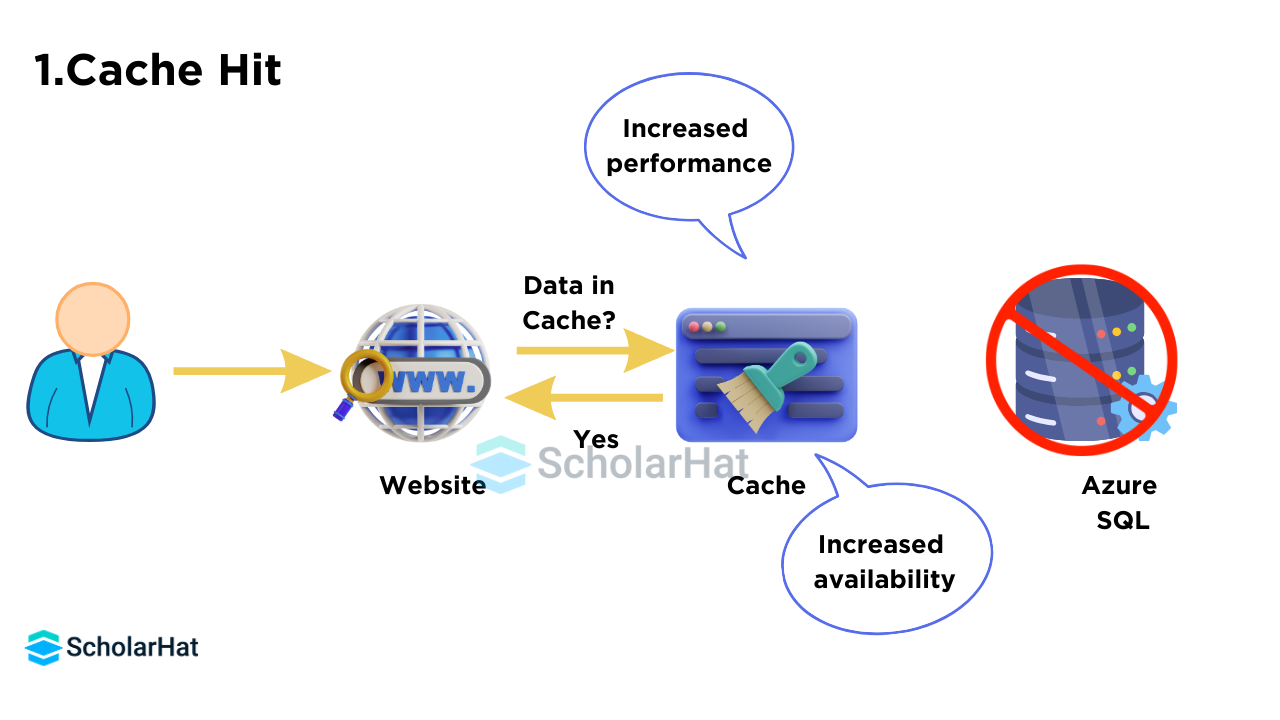
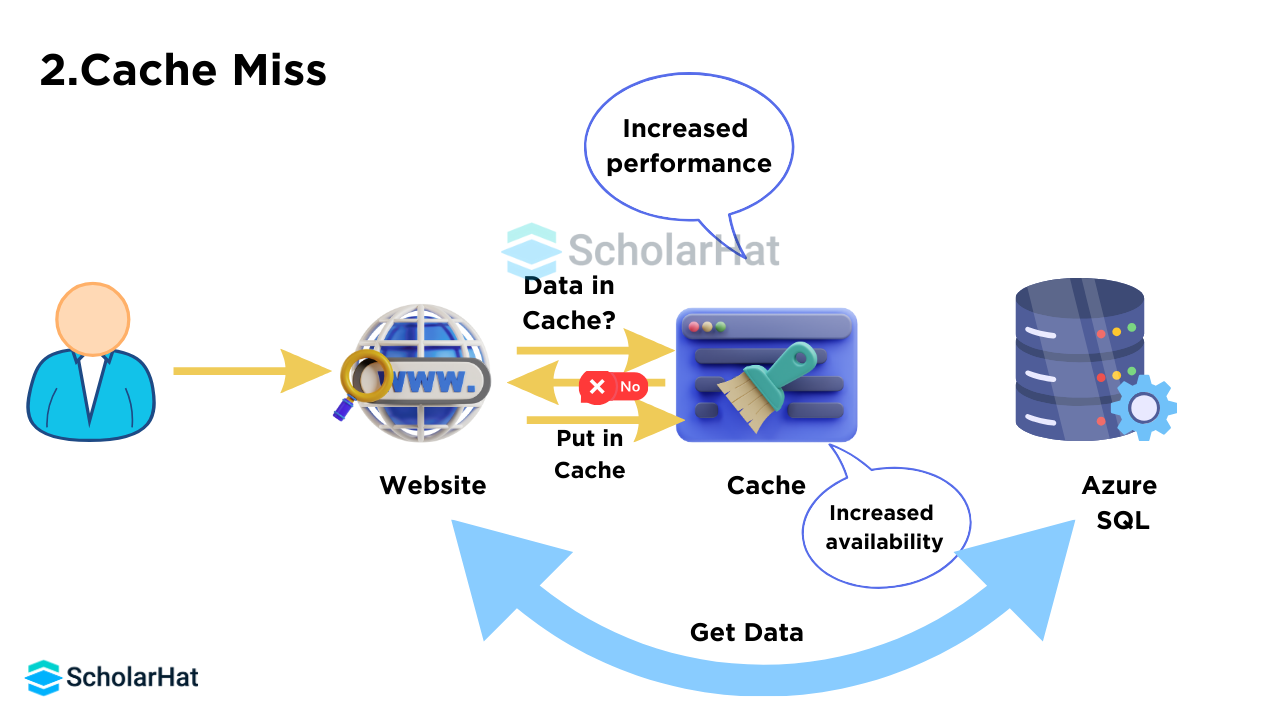
12. Describe the scale sets of Azure virtual machines.
- Sets of identical Virtual Machines (VMs) can be deployed and managed using these Azure compute resources.
- These scale sets have the same configuration and are made to allow applications to autoscale without requiring virtual machines to be pre-specified.
- They facilitate the easier development of large-scale applications aimed at containerized workloads and big data.
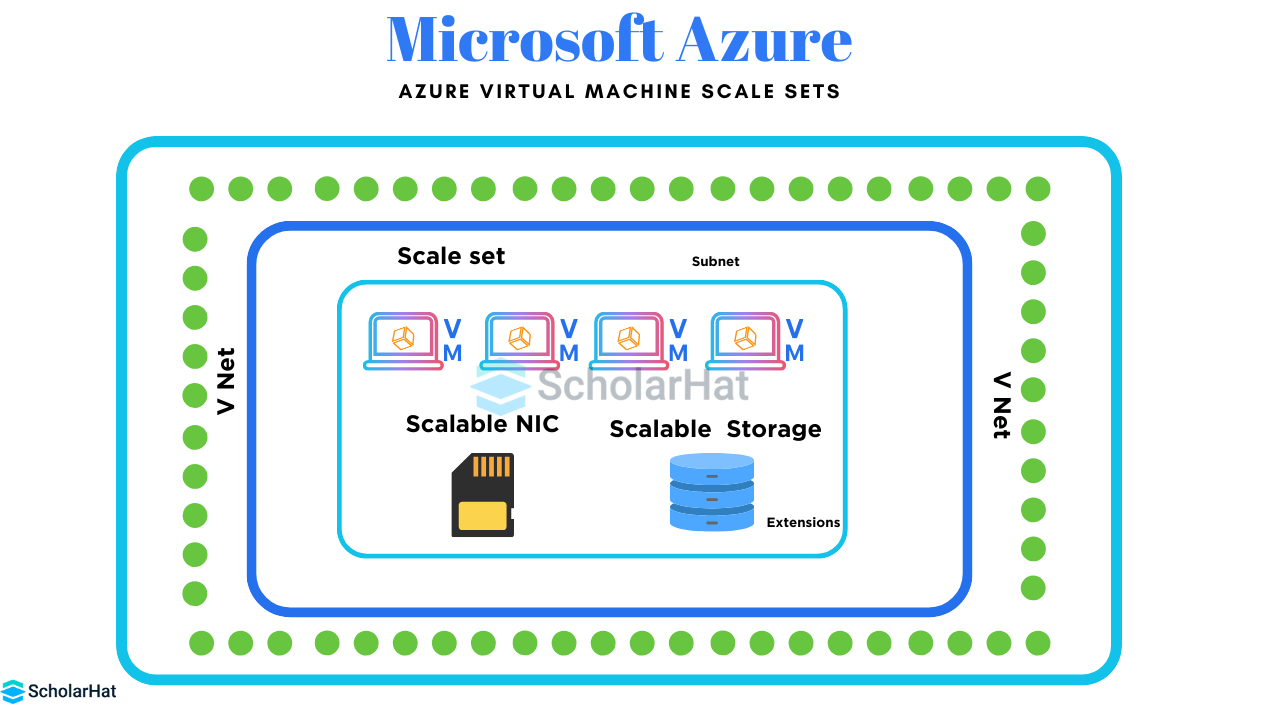
13. What do you know about Azure's "Availability Set"?
All that an availability set is is a logical collection of virtual machines, or VMs, that tells Azure Cloud how an application was designed to be available and redundant. Azure gives you the freedom to set up as many as 20 update domains and three fault domains for each availability set. Azure gives each virtual machine in the availability set one of two types of domains:
- Update Domain
- Fault Domain
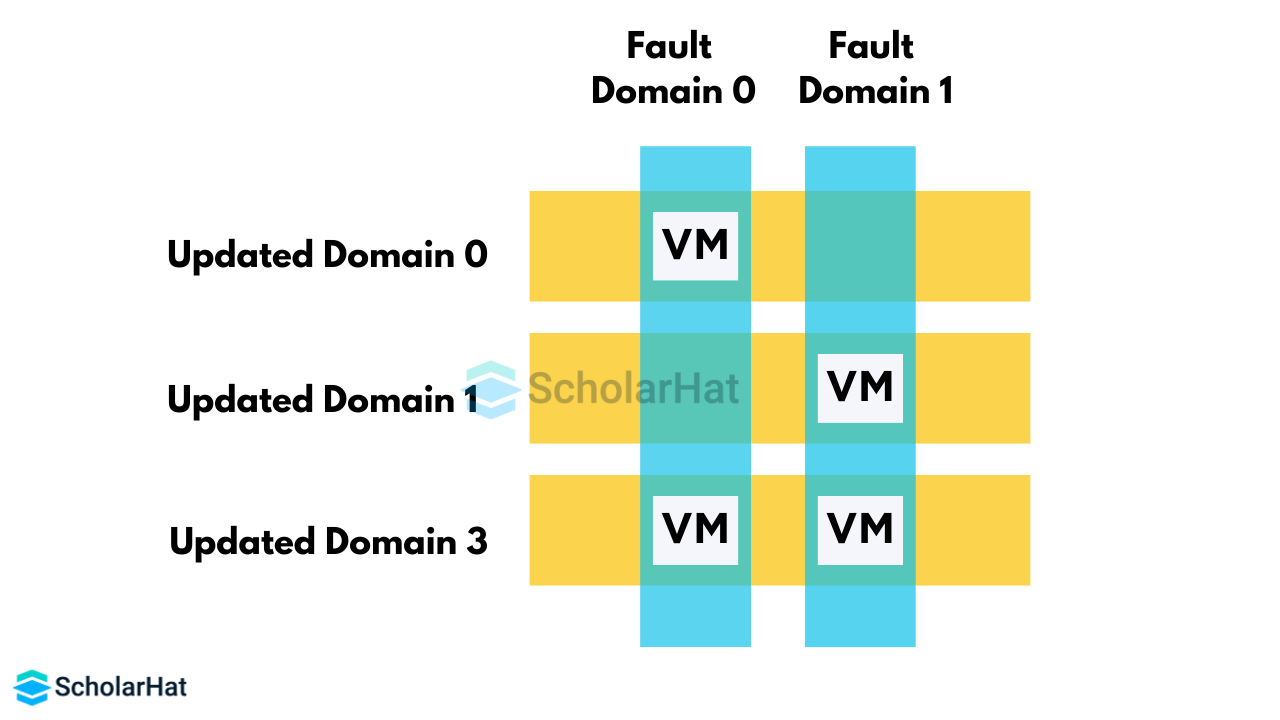
14. What choices are there for Azure's deployment environments?
Two deployment environments exist:
- Staging environment: This is where modifications to an application are tested before going live.
- Production environment: Target users can access applications in this environment using a DNS-friendly URL after they become live.
15. What actions need to be performed in the event that an Azure drive fails?
The actions listed below must be taken in the event of a drive failure:- To guarantee that Azure Storage runs flawlessly, make sure the drive is not mounted.
- Change out the drive remount and format it.
16. Are you able to create Azure applications that can deal with connection failures?
Certainly, the Transient Fault Handling Block makes it feasible. Periodic application-to-database connection failures with more load balancers, slower calls, and timeouts in multi-tenant services, or the frequent user hit resulting in purposeful connection denial to support other tenants in the architecture can all be causes of transient failures in the cloud.17. Define an Azure storage key.
Depending on the needs of the project, an Azure storage key is used to authenticate access to data stored on Azure storage services. Two categories of storage keys are used in authentication:- Primary access key
- Secondary access key, to prevent website or application downtime
18. What is cspack and how does Azure use it?
A command-line utility called CSPack creates the service package file and gets an application ready for Compute Emulator or Azure deployment. The cloud service configuration file, or .cscfg file, created with CSPack, is included in every project including cloud services. It keeps:- The number of role instances in each deployment for each role
- Thumbprints on the certificates
- Configurations that are defined by the user
19. Which Azure option works best for code execution without a server?
Serverless code execution is made possible by Azure Functions, which makes intricate orchestration and resolution easier. They eliminate the need for hard-coded integrations by facilitating smooth connections with other services through their stateless and transient design. With this method, work is sped up and developers can concentrate on writing business logic code. Furthermore, Azure Functions provide performance analysis and monitoring capabilities via Azure Application Insights, which help locate bottlenecks and sites of failure in the application components.
20. Which Azure function is suggested for a shared file-sharing setup amongst several virtual machines?
The Azure File System serves as a single repository for exchanging data between virtual machines that are set up with protocols like SMB, FTP, NFS, and so on.
Azure Interview Questions and Answers for Intermediate
21. Is it feasible to access an Azure Linux virtual machine without entering a password?
It is feasible to access another virtual machine (VM) without requiring a password by utilizing the Key Vault mapping to any Admin VM.22. How do Azure Scale Sets and Availability Sets differ from one another?
The following lists the primary distinctions between Azure Scale Sets and Availability Sets:
| Azure Scale Sets | Azure Availability Sets |
| They are a collection of virtual machines with the same configuration dispersed among several fault domains. | They are the collection of individually configured virtual machines dispersed among different fault domains. |
| These by default update domains and have five fault domains. | These come with three fault domains and five update domains by default. |
| These are used when unpredictable workloads necessitate the auto-scaling capability. | When workload requirements are predictable, these are used. |
| In this case, the virtual machines are set up and made using the same picture in the same way. | Here, various images and parameters are used to construct the virtual machines (VMs). |
| Depending on demand or the predetermined timetable, the number of virtual machines (VMs) can be changed. | An availability set can only have VMs added to it at the time the set is created. |
| In this case, the VM scale sets may be split up over several data centers or contained in a single data center. | Here, a data center's virtual machines are distributed automatically. |
23. What occurs when the number of unsuccessful tries during Azure ID authentication is reached?
Depending on the protocol that analyses the password that was input and the IP address that the login request was made from the Azure account will be locked in this case.
24. Is it possible to get the Azure Internal Load Balancer's public DNS or IP address?
No. Only private IP addresses are supported by Azure Internal Load Balancer.
25. Describe the concept behind Azure Blob Storage.
The cloud's solution for object storage is Azure Blob (binary huge object) storage. It can be used to provide documents, media, or text straight to the browser and can store enormous amounts of unstructured data in binary or text format. You can access the data from any location. The blobs are associated with user accounts and arranged into containers. There are three parts to this service:- Storage account
- Container
- Blob
26. Describe Azure Scheduler and explain how to use it.
With Azure Scheduler, we can call specific background trigger events or actions on demand, such as displaying a message on the queue or contacting HTTP/S endpoints. The jobs that are present in the cloud call services both inside and outside of Azure can be scheduled to start at a future date or to run on-demand according to a regular schedule by using this Azure Schedule.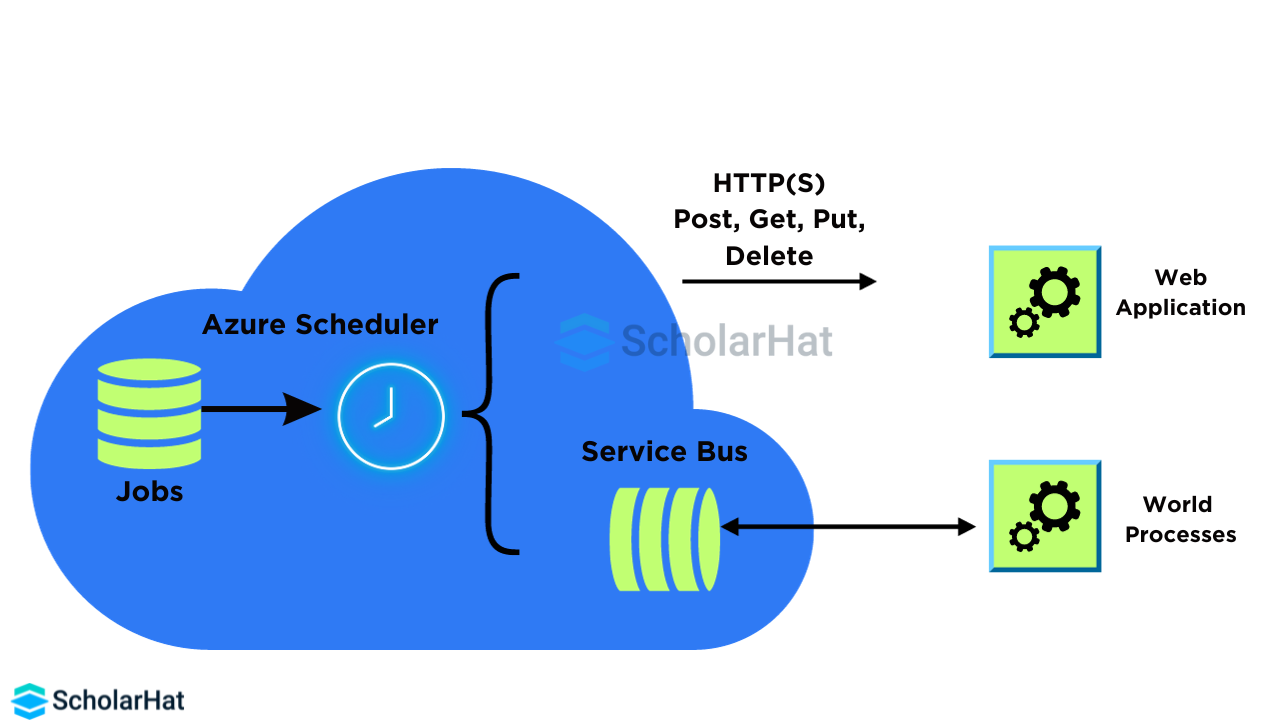
27. Can a Windows computer running on a separate port be mapped to an Azure load balancer?
In Azure, you may achieve this by creating a different load balancer role.
28. When there is no manual help available, which Azure feature can be used to manage heavy application loads?
By using Azure VM Scale Sets to configure conditions for creating new VMs when the application load grows, you may address this issue. Developer-managed scale settings that allow load-balanced virtual machine groups to be created. High availability is ensured by automatic scaling based on application demand or a preset timetable. Large virtual machines (VMs) may be more easily managed, updated, and configured centrally, which helps developers create applications with high data, workload, and compute requirements. When utilizing custom images, the maximum number of virtual machines (VMs) that Azure scale sets can support is 1,000.29. What other kinds of storage services does Azure offer besides blob storage?
In addition to Blob storage, table storage, queue storage, and file storage, Azure provides three more categories of storage services.- Azure table storage: This NoSQL-based key-value store enables the development of applications using semi-structured data.
- Azure queue storage: By creating robust and adaptable applications, the message queue system can manage heavy workloads.
- Azure file storage: SMB (server message block) protocol is used to provide file access and sharing. SMB 3.0 and HTTPS are used to safeguard the data.
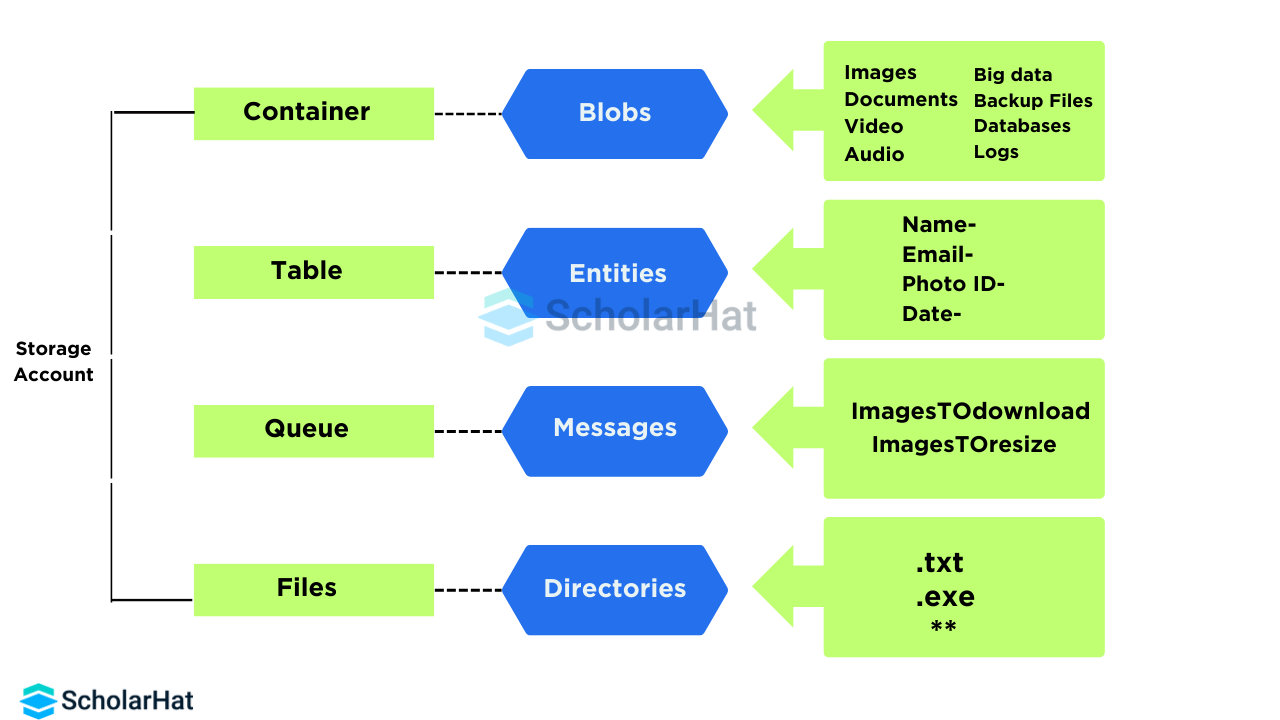
30. Describe Azure's IaaS, PaaS, and SaaS offerings.
- IaaS: Infrastructure as a Service is shortened to IaaS. It provides a number of infrastructure-level functions, like OS and network connectivity. It operates on a pay-per-use basis. It serves as an application host. Examples of this kind of infrastructure are Azure VM and VNET.
- PaaS: Platform as a Service, or PaaS, is an abbreviation. Its main feature is the abstraction of the underlying infrastructure, which enables faster application development without the burden of hosting management. PaaS includes things like storage services, cloud services, Azure web apps, etc.
- SaaS: Software as a Service is referred to as SaaS. These apps are provided under a service delivery paradigm in which an organization only uses the applications. SaaS comes after advertising or subscription-based pricing. SaaS examples include Office 365, Gmail, SharePoint Online, and so forth.
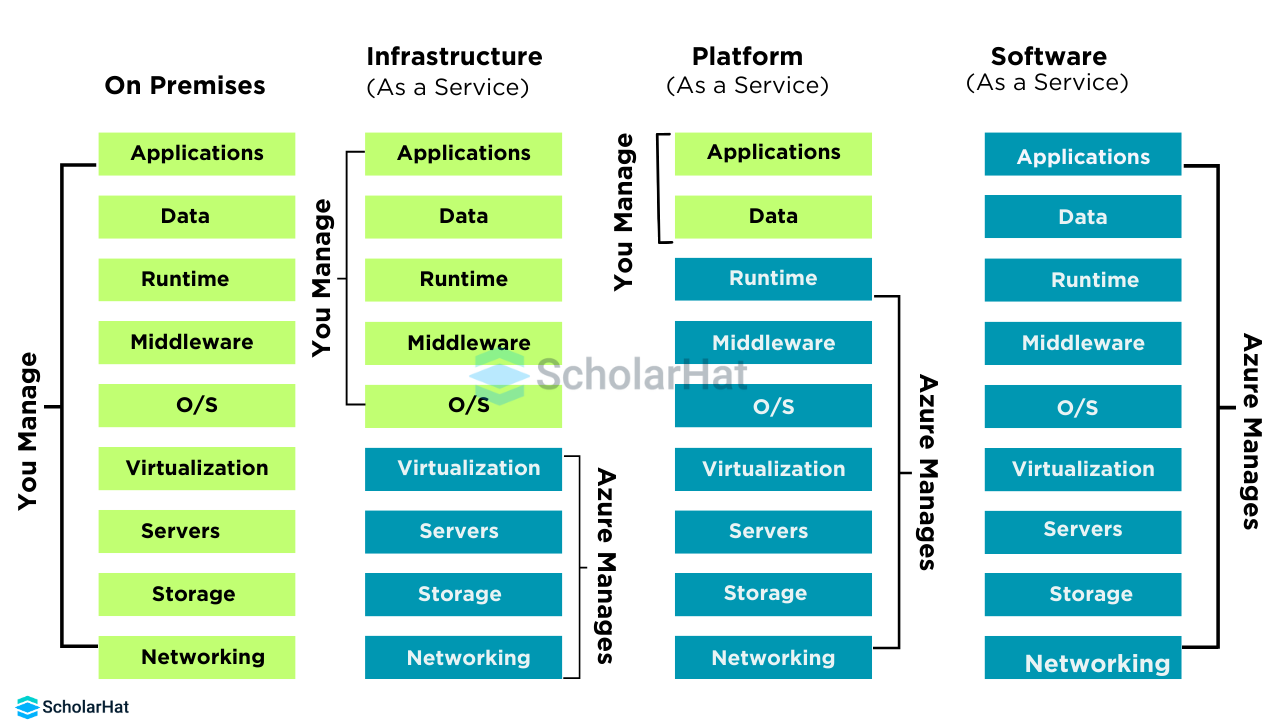
31. What distinguishes Azure SQL service from Azure Table Storage?
The following lists the primary distinctions between Azure SQL Service and Azure Table Storage:
| Table Storage Service | Azure SQL Table |
| This uses Azure's NoSQL storage model. | It is organized according to Azure's relational storage model. |
| This data is called an entity and is kept in key-value format. | Here, the data is kept in an SQL table in a combination of rows and columns. |
| For storage, the data schema is not required. | When a schema violation happens, an error is produced because the data schema is strictly followed for data storage. |
| It is not possible for tables to be related to one another. | Foreign keys are used to define relationships between tables. |
| Each entity's partition and row key combination are thought to be distinct. | A primary key or unique key can be used by the user to define uniqueness. |
| You can store diagnostics data or log information using this service. | Applications that rely on transactions frequently use this service. |
32. How can connectivity be managed in Azure when the database must be on an on-premise server due to security concerns and the application front end is hosted there?
- For a limited number of resources, link an on-premise database to an Azure-hosted application by using the Azure VNET-based "Point to Site" service.
- Take "Site to Site" or "Express Routes" into consideration if you have a lot of resources.
- Although "Site to Site" VPN connections may result in network latency, "Express Routes" offer a dedicated leased line to circumvent this problem.
- Create an on-premise Windows Communication Foundation (WCF) service and host CRUD activities only for the on-premise database if the customer would rather not operate via VNET.
- For database access, use the "Service bus relay" option to facilitate communication between the WCF service and the Azure-hosted application.
33. What distinguishes Azure Service Bus Queue from Azure Storage Queue?
The following lists the primary distinctions between the Azure Storage Queue and the Azure Service Bus Queue:| Azure Storage Queue | Azure Service Bus Queue |
| First In First Out (FIFO) ordering is not guaranteed in this case. | Sessions ensure that the messages are delivered in FIFO order. |
| There is no support for sessions. | Here, messaging-level sessions are supported. |
| The "At Least Once Delivery" model is the only one that is accepted here. | This supports the message delivery modes of "At least once," "Atmost once," and "Exactly once." |
| Here, duplicates are not automatically detected. | This supports the automatic detection of duplicates. |
| Dead lettering is not supported. | Dead lettering is supported. |
| The message has a 64KB size. | The message has a 256 KB size. |
| Supports message delivery one-to-one. | Supports both one-to-one and one-to-many message delivery. |
| There is no support for the transaction. | Here, the transaction is supported. |
| Only batch receive is supported by this queue. | This allows for the sending and receiving of messages in batches. |
| Receiving messages behaves in a non-blocking manner. | Depending on the setup, the behavior may be blocking or non-blocking. |
34. What are the various causes of a client application getting disconnected from the cache?
There are two potential reasons:
- Causes on the client side: It's possible that the application was redeployed. It could have just been a scaling procedure by the application. There have been changes to the client-side networking layer. There could be momentary problems with the client or the network connecting the client and server. Another cause can be that the bandwidth threshold restrictions have been exceeded.
- Causes on the server: It could happen if there is a failover from the primary to the secondary node in the Azure Redis Cache service itself. It's possible that maintenance or patches were applied to the server instance where the cache was installed.
35. How can I create an Azure resource group?
- In Azure, you establish a resource group.
- Login on the Azure website.
- Choose Resource groups from the menu on the left.
- Click Add on the Resource Groups page.
- Enter the information in the following fields
- Choose your Microsoft Azure subscription.
- Enter a unique name for the resource group
- Choose a location for the region
- Select "Review + create."
- After the validation process is complete, click Create to start your resource group.
Azure Interview Questions and Answers for Advanced
36. What is Azure Machine Learning's Text Analysis API?
A collection of web services called the Text Analysis API is available for text analysis. It is used in sentiment analysis and keyphrase extraction studies of unstructured text. It gives results that can be either positive or negative, with a range of 0 to 1.
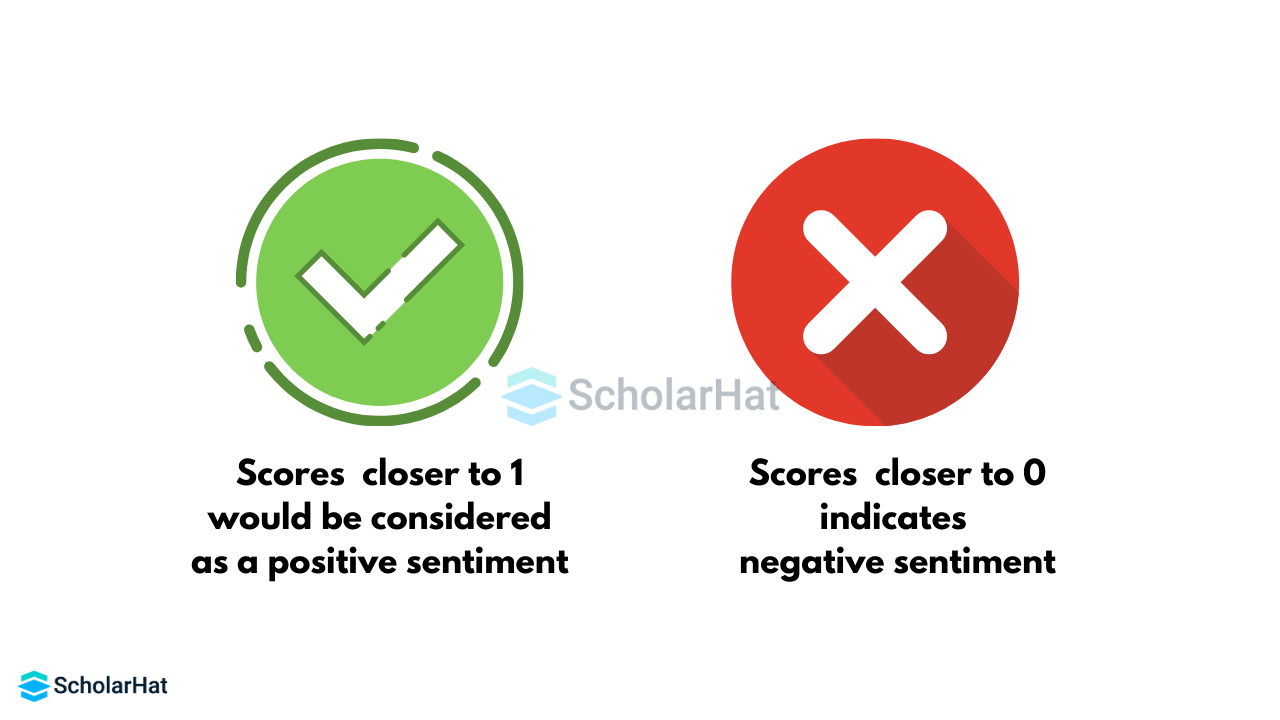
37. What is Service Fabric by Azure?
A quicker time to market is made possible by Service Fabric, which streamlines the development of microservices and application lifecycle management. With a scalability of up to a thousand workstations, it is compatible with Windows and Linux and may be deployed on-site or in several clouds.
38. How do you explain Azure Traffic Manager?
Azure Traffic Manager is a global load balancer for traffic that distributes traffic across Azure regions in an optimal manner, improving responsiveness and high availability. It minimizes application downtime, disperses user traffic across several sites, and offers insights into client connection locations in addition to offering automatic failover choices.
39. Which type of storage is most appropriate for managing unstructured data?
Blob Storage classifies unstructured data into tiers according to how frequently it is accessed, providing scalable storage for it. It supports any unstructured data, guarantees data integrity after every change, and helps improve app speed while using less bandwidth.
40. Describe the advantages of using Azure for scaling.
Some of its benefits are listed below:
- Optimizes the performance of the application
- Adjust the scale in response to demand.
- Scaling the schedule for specific times
- Highly cost-effective
41. What distinguishes Azure Active Directory from Windows Active Directory?
| Windows Active Directory | Azure Active Directory |
| It is a directory service that makes it easier to work unified with a variety of complex, interlinked, and diverse network resources. | Microsoft's multi-tenant cloud-based directory and identity management solution is called Azure Active Directory (Azure AD). |
| 5 layers are used to store data, save user information, issue and maintain certificates, and so on. | 5 layers are used to store data, save user information, issue and maintain certificates, and so on. |
| Works mostly with on-premises components like programs, file services, printers, and so on. | The emphasis is on web-based services with RESTful interfaces. |
42. What types of queues does Azure provide?
Azure queues are in two different types:
- Storage Queues: A component of the Azure Storage system. Makes communication between services and within them easier. Perfect for keeping transaction side logs and more than 80 GB of communications.
- Service Bus Queues: An element of Azure's messaging system. Combines applications from different network settings and protocols. Offers delivery in the FIFO manner, with an 80 GB queue size limit.
43. What benefits does Azure Resource Manager offer?
Users can control how much of their application resources are used by using Azure Resource Manager. Azure Resource Manager offers a number of benefits, including:
- ARM facilitates the deployment, management, and oversight of all the resources for a group, an application, or a solution.
- Access to the resources users need can be provided.
- It acquires thorough billing data for every resource in the consortium.
- Templates greatly simplify the process of provisioning resources.
44. Which web apps are compatible with Azure deployment?
A wide range of online applications, including ASP.NET, Node.js, Java, PHP, Python, Ruby on Rails, Django, Express.js, Flask, and static webpages, can be deployed using Azure. It supports a wide variety of frameworks and languages.
45. What benefits has Azure reaped from incorporating a hybrid cloud?
By designing and delivering cloud and on-premises apps using Azure and the Azure stack, the Hybrid Cloud increases productivity. Azure has benefited from hybrid cloud integration in the following ways:
- Combining DevOps procedures and tools with Azure services, it achieves increased efficiency.
- Customers can benefit from other Azure Marketplace apps and regularly updated Azure services.
- It makes it possible to deploy it on-premises, in the cloud, or wherever it is located.
- As a result, apps can be developed more quickly.
46. What does Azure SQL Federation mean?
For scalability, SQL Azure introduces organization. The federation facilitates information scaling for developers as well as managers. It facilitates managers by simplifying information dispersing and repartitioning. It gives developers access to the information exchange and routing layer. It facilitates routing without causing application lag.
47. What are the various storage options that Azure provides?
Azure provides four different kinds of storage:
- Azure Blob Storage: Metadata-enabled storage for unstructured media, including pictures, music, and movies. Offers REST-based access, flexibility, and version verification.
- Azure Table Storage: Works with NoSQL key-value stores and semi-structured datasets. Supports enterprise emphasis, robust consistency, and configurable data schema.
- Azure File Storage: Offers data protection together with file sharing via SMB protocol. Improved on-premises performance and capabilities, under Azure management.
- Azure Queue Storage: Offers a message queuing in large workloads. Permits queue monitoring, scalability, and flexible application development to satisfy client requests.
48. What makes using Azure CDN recommended?
The load time and bandwidth are decreased with Azure CDN. Additionally, it facilitates faster reactivity.49. What types of backups are available in Azure?
Three different replication types are included in Azure Backup to maintain highly available storage and data:- GRS, or geo-redundant storage: The default and suggested setting, which duplicates data to a secondary area distant from the original site
- Storage that is redundant locally (LRS): Creates three copies of the data in a data center's storage scale unit.
- ZRS, or zone-redundant storage:Has no downtime and replicates the data in availability zones with data residency and resilience in the same location.
